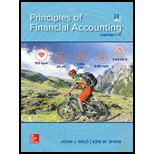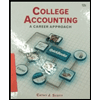
Concept explainers
Recording sates, purchases. shipping. and returns—buyer and setter
P1 P2
Sydney Retailing (buyer) and Troy Wholesalers (seller) enter into the following transactions. Both Sydney
and Troy use a perpetual inventory system and the gross method.
Check (1) May 20. Cc Cash. $37,442
May 11 Sydney accepts delivery of $40,000 of merchandise it purchases for resale from Troy: invoice dated May 11, terms 3/10, n/90. FOB shipping point. The goods cost Troy $30,000. Sydney pays $345 cash to Express Shipping for delivery charges on the merchandise.
12 Sydney returns SI,400 of the $40,000 of goods Co Troy, who receives them the same day and restores them to its inventory. The returned goods had cost Troy $1,050.
20. Sydney pays Troy for the amount owed. Troy receives the cash immediately.
1. Prepare
2. Prepare journal entries that Troy Wholesalers (seller) records for these three transactions.
Exorcise 5-23c
Recording sales, purchases. shipping, and returns: buyer and seller-perpetual nod net method P7
Refer to Exercise 5-7 and prepare journal entries to record each of the merchandising transactions assuming that the perpetual ¡memory system and the net method are used by both the buyer and the seller.
Trending nowThis is a popular solution!

Chapter 5 Solutions
Principles of Financial Accounting.
 College Accounting (Book Only): A Career ApproachAccountingISBN:9781305084087Author:Cathy J. ScottPublisher:Cengage Learning
College Accounting (Book Only): A Career ApproachAccountingISBN:9781305084087Author:Cathy J. ScottPublisher:Cengage Learning College Accounting (Book Only): A Career ApproachAccountingISBN:9781337280570Author:Scott, Cathy J.Publisher:South-Western College Pub
College Accounting (Book Only): A Career ApproachAccountingISBN:9781337280570Author:Scott, Cathy J.Publisher:South-Western College Pub College Accounting, Chapters 1-27AccountingISBN:9781337794756Author:HEINTZ, James A.Publisher:Cengage Learning,
College Accounting, Chapters 1-27AccountingISBN:9781337794756Author:HEINTZ, James A.Publisher:Cengage Learning,- Principles of Accounting Volume 1AccountingISBN:9781947172685Author:OpenStaxPublisher:OpenStax College
 Financial Accounting: The Impact on Decision Make...AccountingISBN:9781305654174Author:Gary A. Porter, Curtis L. NortonPublisher:Cengage Learning
Financial Accounting: The Impact on Decision Make...AccountingISBN:9781305654174Author:Gary A. Porter, Curtis L. NortonPublisher:Cengage Learning





